A Tedious Explanation of Depth of Field
by Matthew Cole
In my A Tedious Explanation of the f/stop page I go into a lot of explanation of f/stops, whose numbering system is often confusing to photographers. That page also briefly discusses shutter speeds, since both the shutter speeds and f/stops work through sequence of doubling/halving steps which are complimentary. I note that for any given level of subject illumination and ISO, there is a whole range of exposure combinations which give the correct amount of light on the film or sensor. And I make a passing reference to the other effects that your choice from among these combinations will have on your photograph. I'll again touch on the shutter speeds, then go into more in-depth discussion about f/stops and how they affect your depth of field in combination with other factors like film or sensor format and lens focal length, which are actually kind of related.
Shutter Speeds and the ability to stop action
To review quickly, shutter speeds are the easier control to comprehend. The full range of shutter speeds from a traditional film camera like my Nikon FM3A, goes like this:
1 second 1/2 second 1/4 1/8 1/15 1/30 1/60 1/125 1/250 1/500 1/1000 1/2000 1/4000
It's pretty clear that the shutter speed, on these settings, doubles and halves throughout the range. One-half second is half the time of one second; 1/4 second is half the length of time as 1/2 second; 1/8th is half of 1/4; and on down the list. These are all fractions of a second, but it's pretty intuitive to understand that more action and movement will happen in 1/2 second than will happen in 1/4 second, and that more things will happen in 1/500th of a second than will happen in 1/1000th of a second. If you are trying to stop action, the shorter the length of time the shutter is open the more you will be able to "freeze" the action. It's pretty common these days for cameras to have 1/2000 or 1/4000th of a second shutter speeds. If there is sufficient light, and that's a big "if", you can set a very fast shutter speed and freeze the action to your heart's content.
The flip side of setting your shutter speed is that you also have to change your f/stop. If you've got 1/125th at f/8 and you want to freeze action, you could go to 1/2000th at f/2. If you wanted to artistically blur action, you could go the other way, to maybe 1/15th at f/22. It's pretty intuitive to understand that there is going to a lot more action happening during 1/15th of a second than there is during 1/2000th of a second. If you've caught on to the f/stop concept, you'll also realize that these are all the same exposure, the same amount of illumination on the film or sensor. Here's the whole set at the full f/stop and shutter speed settings comparable to an exposure of 1/125th at f/8:
| Shutter Speed
|
1/4 second
|
1/8
|
1/15
|
1/30
|
1/60
|
1/125
|
1/250
|
1/500
|
1/1000
|
1/2000
|
1/4000
|
| f/stop
|
f/45
|
f/32
|
f/22
|
f/16
|
f/11
|
f/8
|
f/5.6
|
f/4
|
f/2.8
|
f/2
|
f/1.4
|
Remember, every one of those combinations gives the same exposure, the same amount of light on the film or sensor. As you move up and down the shutter speed range, you are changing your ability to stop action (and also your ability to hand-hold the camera without blurring the photo due to body motion). What about the f/stop? What's changing there? Is it just some neutral balancing control with no other effects? Nope. As you change the f/stop, you are affecting the depth of field (DOF), that is, the amount of subject matter on either side of your focus plane that is acceptably sharp. That's what we're going to talk about the rest of this page.
Note: As with most of my pages, you can click on the photos to see a larger version, often useful in seeing the effects I'm discussing.
Depth of field - What it is and what affects it
Note: I am in the process of re-posting the photos at much larger sizes but at the moment there is still an awkward and not completely attractive mix of sizes. It'll be fixed soon.

Narrow depth of field can be a subtle thing. Here the only thing really in focus is the bit of face around Tilly's eyes. The rest of her face gets softer and her legs are really soft yet provide the context for the shot without being razor sharp and, even though technically out of focus, you still get the idea that one of her feet appears to be missing (it's not). Thinking about things that affect DOF, this is
(a) a fairly open f/stop,
(b) slightly longer than normal lens and
(c) close to the subject. All three of those work towards limited DOF.
Nikon D700 (full frame), 62mm in a 28-85mm lens, 1/180th at f/4.8, ISO 320
Depth of field is the amount of subject matter in front of and behind your plane of focus that appears to be in focus. When we say "that appears to be in focus" or "is acceptably sharp", understand that this is a continuum, it's not like objects in the depth of field range are razor sharp and then suddenly the sharpness falls off a cliff. Things get gradually less sharp until they are perceived as being "out of focus". Is there a technical spec for what is acceptably sharp? Yep, I'm not going to go into it, but if you are interested, try googling the appropriately named "circles of confusion". When you're done, you'll know some arcane information but from a practical point of view I don't think it'll help your photography all that much.
As a practical matter, these are the the things that affect depth of field
- the f/stop
The smaller the f/stop (the larger the number, the smaller the diameter of the aperture), the more depth of field there is. At f/2 (small number, big aperture), you will have comparatively narrow depth of field, with little in focus on either side of your focus point; at f/16 (big number, small aperture), you will have comparatively more depth of field, with more subject matter in focus on either side of your focus point. I say "comparatively" for a reason. If you've read my f/stop page, you know that from a brightness point of view, measuring the amount of light hitting the film or sensor, f/2 is f/2 regardless of the lens. This isn't the case with depth of field. The amount of depth of field at f/2 will also depend on...
- ...the focal length of the lens
The shorter your focal length, the more depth of field you will have. A 20mm lens will have more depth of field than a 50mm will have more than a 100mm. With really short lenses, like 4 mm, you will have immense depth of field. With long lenses, like 400mm, you will have miniscule depth of field.
- the distance to the subject
The closer you are to your subject, the less depth of field there will be. The further away you are, the more depth of field you will have.
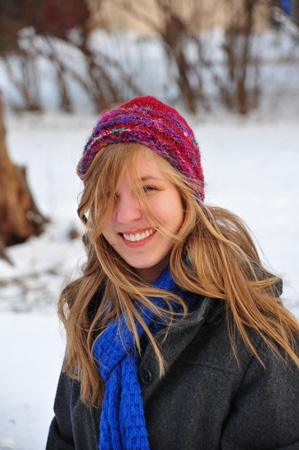
Narrow depth of field can be more obvious. This is a pretty standard use of limited depth of field, for a portrait (although this is a snapshot, not a formal portrait). If I'd paid more attention, I could have narrowed the DOF even more by opening up some more. Thinking about things that affect DOF, this is
(a) fairly open f/stop,
(b) longer than normal lens and
(c) fairly close to the subject.
Nikon D700 (full frame), 85mm lens, 1/180th at f/4.8, ISO 400
That second item, the focal length of your lens, has a wrinkle to it. On one hand, it's pretty straightforward in that the depth of field of a 50mm lens at, say, f/8, is the same regardless of what camera the lens is on. The wrinkle is that the 50mm lens can be wide angle, normal or telephoto depending on the camera body to which it is attached and format of the film or sensor of that camera. This sounds like some theoretical aside, but in fact has some important implications in this digital age. This is because in the film days, just about everyone used 35mm film and lenses in the same focal length range; now, in digital, sensor sizes vary from tiny to full-frame 35mm sized and even beyond. There is no standardization on sensor size, and each size comes with its own requirements for focal lengths. In general, now that digital has taken over, sensors are smaller than film was, the lenses are shorter, and the depth of field is greater. If you want everything in focus all the time, this is great. If you'd like to be able to throw some things out of focus every once in a while, this can be a challenge.
Not in focus? Who'd want that? Well, not everyone wants everything in focus all the time, and many people equipped with lovely little digital cameras or a smartphone camera find it easy to get lots of depth of field and surprisingly difficult to get limited depth of field. This has to do with the relationship of film formats/sensor sizes to the focal lengths of lenses used. It can be annoying because limited depth of field, to make your subject stand out against the foreground and background, is a pleasing way to isolate and emphasize your subject. In fact, a lot of filmmakers are wetting themselves with excitement as DSLRs start being able to do HD video for this very reason; they get to use longer lenses and get less depth of field and (separately) the ability to do real wide angle work. They'll say it has the "film look". A big part of this is the limited depth of field resulting from longer lenses. The next bit of this page goes into this some more (remember, this is a Tedious Explanation!) and you can safely skip it and move down to the next section.
A Diversion into Film Formats, Sensor Sizes and Normal Lenses
The key thing to understand here is that when you buy your camera or camera body, you are by default setting yourself up for different ranges of lens focal lengths for wide angle, normal and telephoto views. We're going to talk a bit about the "normal" lens for a camera. Once you know what the normal lens is (and I will stop putting in quotes from here on out), you'll know that any focal length shorter than that is wide angle, and the shorter it gets, the wider-angle it gets, and that anything longer than normal is telephoto, and the longer it gets, the more telephoto the lens is.
Figuring out the normal lens is pretty easy. All you need to know is the size of your film or sensor. Lens focal lengths even on small point'n'shoots are often referred to in terms of their 35mm equivalents, so I am going to start with 35mm film/full frame digital frame sizes as a reference. In 35mm film cameras or "full frame" digital like my Nikon D700, the actual image size is 24mm X 36mm. The normal lens is generally thought to be the diagonal of the image size. Film formats are rectangular or square, all right angles, so to figure the diagonal we just use the formula for the hypotenuse of a right angle, that is, the square root of the sum of the squares of the adjacent sides. Eyes starting to glaze over? It's easy. Add up 24 squared (576) plus 36 squared (1,296) to get 1,872. Take the square root of that (43.3) and you get the normal focal length for a 35mm camera.
How does that relate to real life? Most 35mm film SLRs came with a 50mm lens as the normal lens, slightly longer than the 43mm calculated above. On the other hand, many excellent compact film cameras came with 40mm lenses (a hair wider) and my film Contax G2 had a 45mm normal lens. Anything shorter than 43mm would be wide angle, anything longer telephoto (well, 50mm is hardly telephoto, just sort of a long normal). It was pretty common for 35mm autofocus point and shoot cameras to have slightly wider lenses to get more in focus with greater depth of field (I have a 1980 Olympus XA rangefinder, a 1987 Nikon One Touch autofocus and a 1994 Yashica T4, all film cameras with 35mm f/2.8 lenses). Even though a couple of these cameras were pretty tiny, the 35mm lens has the same depth of field as putting a 35mm lens on a film or full-frame digital SLR. Interestingly, this 35mm focal length also has limited enough depth of field at some f/stops that all three cameras have some focusing mechanism.
Why should you care? Because nowadays the 24 X 36mm film-sized sensor is considered huge. Most digital SLRs (DSLRS) have somewhat smaller sensors, often couched in terms of APS sizes (APS stands for Advanced Photo System, a late attempt by the now-bankrupt Kodak at a simple consumer film format for those for whom loading and rewinding 35mm was too complex). The typical tiny compact digital point and shoots are even smaller cameras with even tinier sensors. (To see the differences, take a look at and maybe even print out my Sensors and Lenses page, which draws out the sensor sizes of many common cameras).
Remember, a smaller format sensor or film is going to take a shorter lens to be normal, and shorter focal lengths have greater depth of field. Since I am all about some concrete examples, here is a table of common cameras (common to me, anyway, because I own or have owned several of them!) and their film/sensor sizes. I start with the medium-format Mamiya 6 film camera, then step down to 35mm film/"full frame" digital, then through a set of digital cameras with smaller and smaller sensors. I show all these examples because there has been a real proliferation of formats; with these, you can take the logic shown here and apply it to any camera you may be considering.
Camera |
Film/
Sensor Size |
Image Area
(sq. mm) |
Diagonal/
Normal Lens |
Comments |
| Mamiya 6 |
56 x 56mm |
3,136 |
79.2mm |
Actual normal lens: 75mm f/3.5 |
Nikon FM3A (film)
Nikon D750 (digital) |
24 x 36mm |
864 |
43.2mm |
Usual normal lens: 50mm |
| Canon Rebel |
16.9 x 22.3mm |
332 |
26.8mm |
Called the APS-C by Canon |
| Sony DSC-R1 |
14.1 x 21.5mm |
305 |
25.5mm |
Actual lens: 14.3 - 71.5mm |
| Panasonic GF-1 |
13.4 X 18mm |
241 |
22.4mm |
The micro 4/3rds System. Comes with 20 f/1.7 |
| Panasonic LX-3 |
6.2 x 8.3mm |
52 |
10.4mm |
Actual lens: 5.1 - 12.8mm |
| Canon G11/S100 |
5.7 x 7.6mm |
43 |
9.5mm |
Actual lens: 6.1 - 35mm (on the G11) |
| Kodak V705 |
4.3 x 5.8mm |
25 |
7.2mm |
Had two lenses. |
OK, that was fun. What's it all mean? Remember the general rules of depth of field? The shorter the focal length, the greater the depth of field. In the tiny cameras, like the Kodak V705, the sensor is tiny and the lens is correspondingly short. With the very short lenses, there is immense depth of field and if you want to throw the background out of focus it's going to be really difficult or perhaps impossible. This, by the way, is how the iPhone 3G got by with a non-focusing lens. Apple was a bit vague on how big the sensor is, but it's around 10 sq mm with a 4 mm lens with such immense depth of field it doesn't need to focus.
At the other end of the scale, the Mamiya 6 with its veritable acres of image area and standard 75mm lens commonly had narrow depth of field, and in fact, getting deep depth of field was something of a challenge.
A handy point of reference here is a 20mm lens. I have one I bought in 1985 for my Nikon FE and at the time it was considered a pretty radical wide angle, not quite exotic, but not common either. One of the side-effects of the focal length was pretty huge depth of field. Now consider the Kodak V705; it has a lens touted as equivalent to a 39-117mm on a 35mm camera, plus a separate 23mm equivalent. These lenses are actually 6.5 to 19.5mm and then slightly less than 4mm for the wide angle. At the most extreme telephoto setting on this camera, the focal length is slightly less than what used to be considered a really wide-angle SLR lens. For the 4mm lens, my guess is they don't even bother focusing.
The implications? Well, you get a really tiny camera, which is pretty handy. With the short focal lengths, you have to work at it to get your subject out of focus. On the other hand, it is nearly impossible to throw the background out of focus. This is a pretty common method of isolating a subject, and on cameras like this (tiny with short little lenses) it is just about unachievable.
Another implication? One camera that enthusiasts are wetting their pants with excitement over is the Panasonic GF-1 with it's normal 20mm f/1.7 lens. Now, to be clear, I think this looks like an excellent camera, pretty small but with a comparatively large sensor. However, discussion boards have references to how this huge sensor and fast lens will give the ability to throw backgrounds out of focus. I think some of these folks will be disappointed on this point. For all the lovely features of the camera, it's still a 20mm lens. Sure, f/1.7 is pretty fast (my Nikon 20 is f/2.8, about 1.5 stops slower) but stop down at all and everything will come back into focus.
Further Examples of Depth of Field Great and Small
Every photo you take has its own depth of field. You can control this by your conscious decisions on format, focal length and distance from the subject. Do photographers think hard about this with every photo they take? I don't know about everyone else, but I sure don't. There are times when I clearly want more or less depth of field and pay attention but there are also lots of times when I just take whatever the camera is doing for exposure without question or use f/8 because it's generally about the sharpest aperture for a lens and take whatever the depth of field happens to be. Makes me a bit sloppy, I suppose, but I think it also makes me typical. When I was first learning photography I do recall being disappointed many times with how pictures came out and after a while it finally occurred to me that what was happening was that I was focusing with the lens at f/1.8 but the photo was being taken at f/8. When we had to focus oursevles, focusing wide open was typical and made focusing easier--the limited depth of field made it clearer what's in and what's out of focus. Then you took the photo and the lens stopped down and when the film came back you saw an alarming amount of detail in the background. Now, with digital and the ability to chimp the screen on the camera after taking the photo, you can be disappointed right away and reshoot.
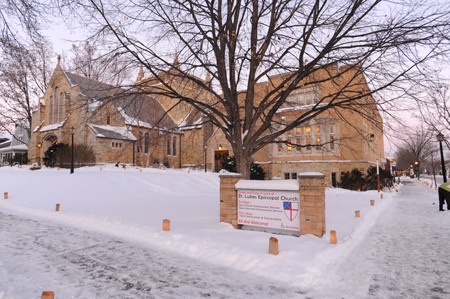
Sometimes you want a lot in focus. Here, the sign in the foreground and church in the background are all pretty sharp. Thinking about things that affect DOF, this is
(a) fairly open f/stop, which doesn't really help,
(b) short focal length and
(c) distant from the subject.
Nikon D700 (full frame), 22mm in a 17-35mm lens, 1/125th at f/4, ISO 1600
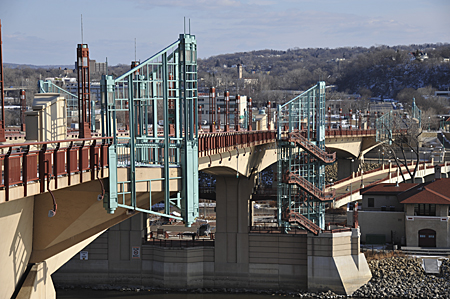
Stopped down enough, even telephoto lenses can have deep depth of field. In this unexciting look the Wabasha Street bridge, you can see that the railings from foreground left to the scenery in the background is all in focus. Thinking about things that affect DOF, this is
(a) stopped down,
(b) just a short telephoto lens, and
(c) pretty far from the subject.
Nikon D700 (full frame), 85mm in a 24-120 f/4 lens I was testing, 1/400th at f/8, ISO 200
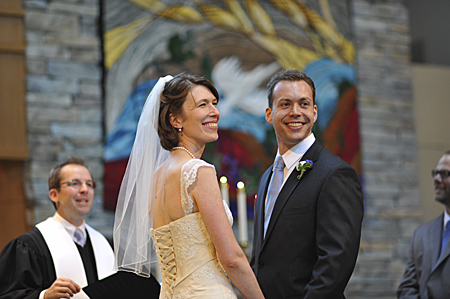
Sometimes you want hardly anything in focus. In this case, I wanted the bride primarily in focus, with the groom close if not razor-sharp, then the rest out. In terms of depth of field, I used
(a) a wide-open f/stop on this fast telephoto,
(b) a medium-long focal length and
(c) was distant from the subject, which doesn't help. This particular lens, the Nikon 135 f/2 DC, actually gives you the ability to fiddle with the quality of the out-of-focus areas with a separate Defocus Control ring (hence the DC). This doesn't affect DOF, but it does affect the appearance of the out-of-focus stuff. In this case, the DC was set for f/2, Rear.
Nikon D700 (full frame), 135mm lens, 1/320th at f/2, ISO 1600
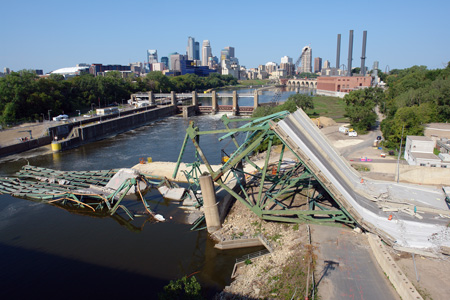
In this case, the great depth of field provides context. This camera (the R1 was a bulky predecessor of Sony's current Alpha cameras) has an APS-C sensor so the lenses are shorter for a given field of view. Thinking about things that affect DOF, this is
(a) stopped down,
(b) shorter than normal lens, partly because of smaller sensor, and
(c) far away from the subject.
Sony DSC-R1 (APS-C format), 14.3mm lens, 1/400th at f/8, ISO 160
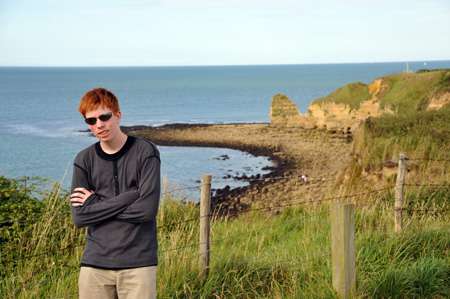
If the subject is relatively close to you, it's not too hard to make the background softer, as in this photo. If you understand depth of field well, you can focus behind your subject but not to infinity and get both sharp. The concept is called hyperfocal distance. Getting limited depth of field, as in this shot, is straightforward on a 35mm camera or full-frame digital, but gets increasingly difficult as sensors get smaller, lenses get shorter and depth of field increases. In considering things that affect DOF, this is
(a) stopped down partway, which tends to increase depth of field
(b) slightly longer than normal focal length and
(c) relatively close to the subject. Note that stopping down does nothing about straightening horizons!
Nikon D700 (full frame), 62mm in a 24-85mm lens, 1/250th at f/8, ISO 200
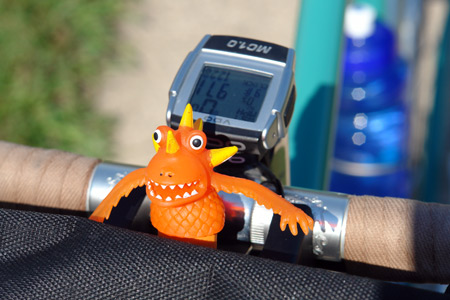
Depth of field is limited up close. This is a relatively long lens (on an APS-C sensor camera) stopped down. You can see the shape of the aperture blades in the out-of-focus highlights off the water bottle in the background. Thinking about things that affect DOF, this is
(a) stopped down,
(b) longer than normal lens and
(c) very close to the subject.
Sony DSC-R1 (APS-C format), 71.5mm lens, 1/320th at f/9, ISO 160
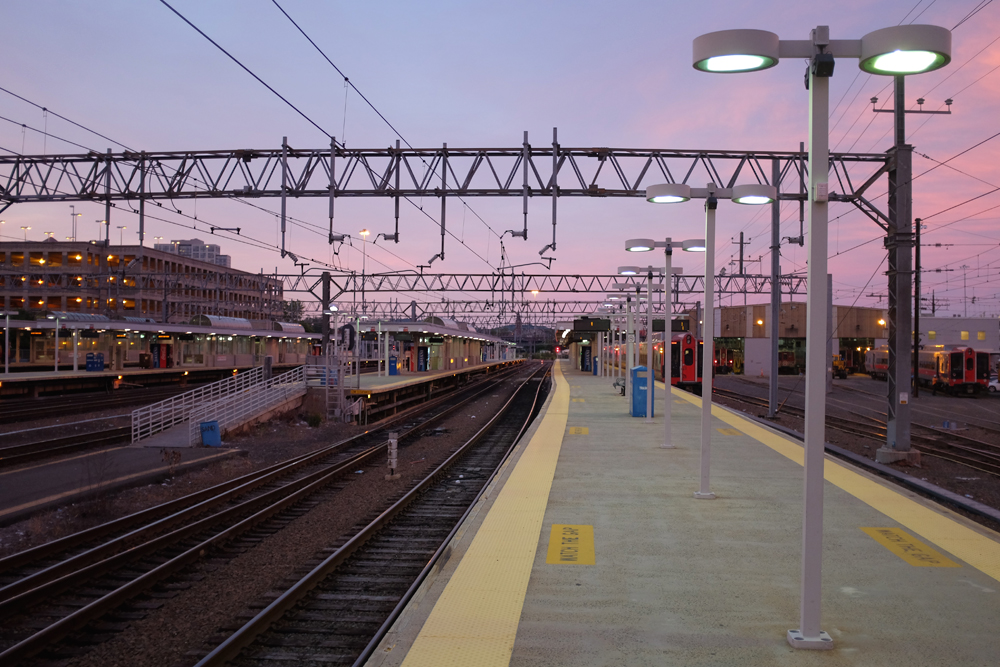
When you're pretty distant from your subject the depth of field will be pretty big even wide open. This photo at the New Haven train station one July evening is at f/2 on a 23mm lens, wide open in this case, yet everything is acceptably sharp and in focus.
Fujifilm X100S (APS-C), 23mm lens, 1/250th at f/2, ISO 1000
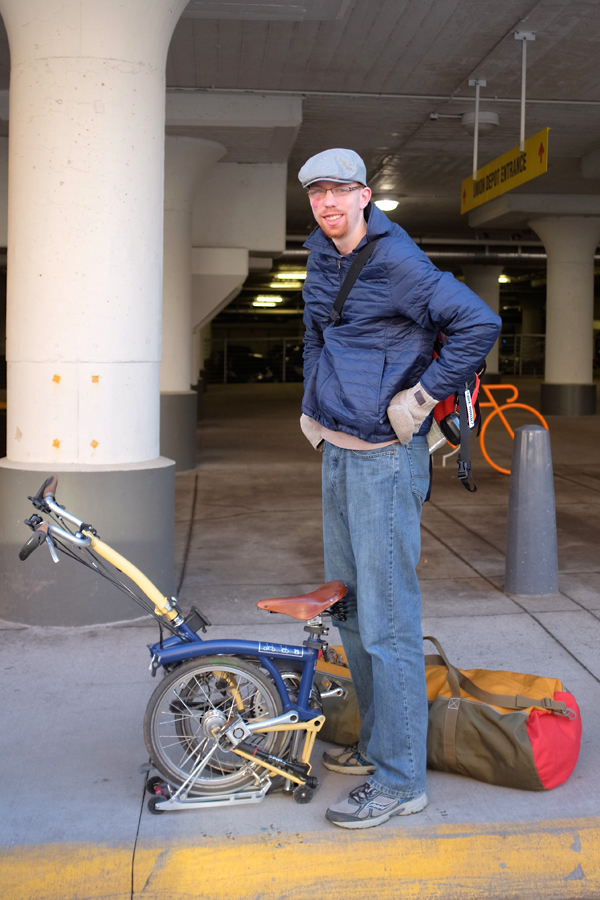
In the middle distance, the limited depth of field begins to assert itself, though subtly. Here, Henry at another train station with the same camera and aperture throws the background slightly soft compared to the sharpness of his face or the seam on his jeans. Saint Paul's Union Station, about to catch the Empire Builder back to Winona, January 2015.
Fujifilm X100S (APS-C format), 23mm lens, 1/320th at f/2, ISO 400
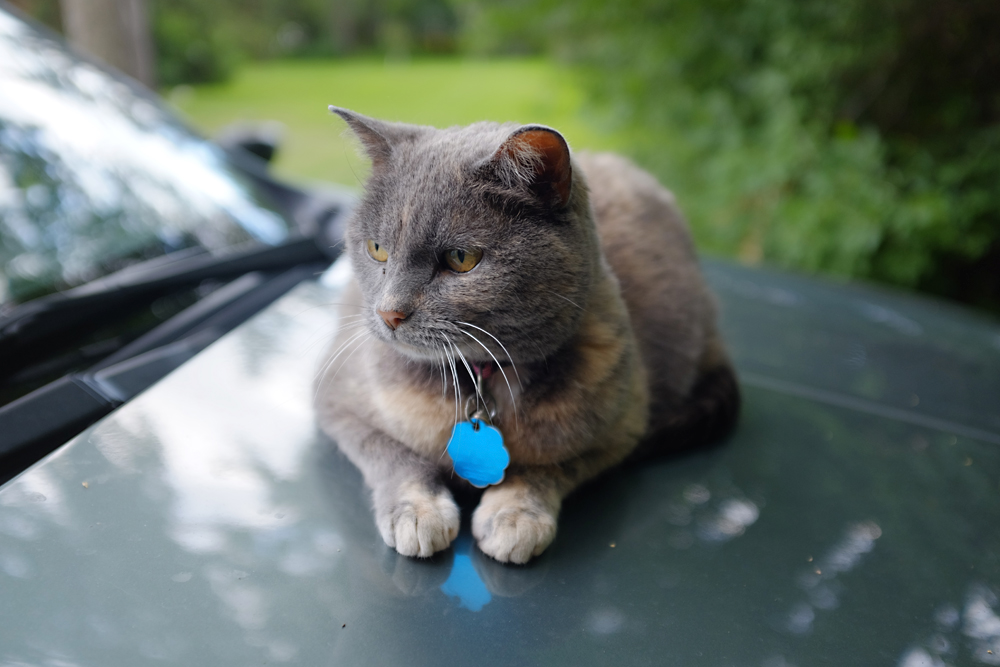
Sticking with the same camera, lens and f/stop, you can see that getting really close makes the dept of field very shallow.
Fujifilm X100S (APS-C), 23mm lens, 1/180th at f/2, ISO 400
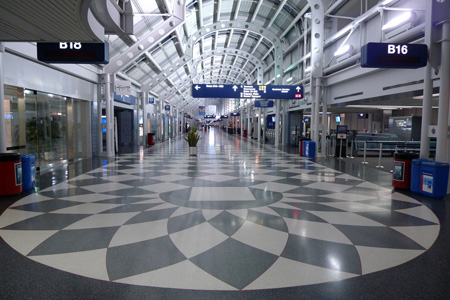
As your camera sensors get smaller and lenses get shorter, immense depth of field gets easier to achieve. In this case, the photo is in focus from a few feet in front of me off into the distance despite being wide open. In considering things that affect DOF, this is
(a) at f/2, wide open on this lens, which doesn't help at all, but with
(b) a very short focal length lens and
(c) relatively far from the subject.
Panasonic LX-3, 5.1mm focal length, 1/20th at f/2, ISO 200
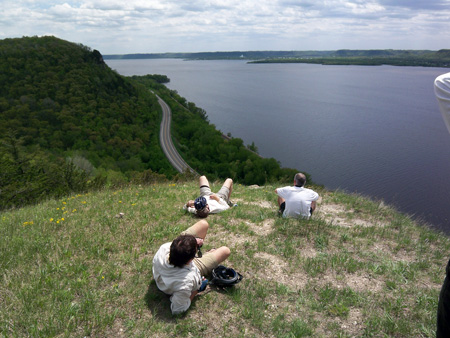
With really short lenses, as found on tiny cameras, depth of field is immense. In this case, virtually everything is in focus but the critical sharpness is becoming compromised by the tiny sensor. Thinking about things that affect DOF, this is
(a) stopped down a bit with a
(b) very short focal length and
(c) not too close to the subject.
Kodak V705, 3.8mm lens, 1/320th at f/5.6, ISO 50
Those photos give at least a smattering of examples. I'll add more as time goes on.
So, in-camera, can I see what my depth of field looks like? That depends. Traditionally, nice film SLRs and some digital SLRs have a depth of field preview button which would stop the lens down so you could see the effects. This was a pretty alarming thing to see the first time because not only did it show depth of field, it also got real dark. If you were focusing at f/1.4 and then stopped down to f/11 to see how things looked, you had to learn to ignore the loss of 98% of your light and pay attention to the background. On other cameras (Mamiya 6, Rolleicord Vb), there were depth of field scales on the lenses (or around the focusing ring of the Rollei) which served as the only DOF aid. On yet others (cheap little Olympus XA, fancy Contax G2), there was no preview or DOF scale at all and you were left guessing or relying on your, ahem, extensive photographic knowledge. Some cameras had a couple of provisions; my film Nikon FM3A (and the FE before it, and virtually all film Nikons) had both a depth of field preview button and the manual-focus lenses had DOF scales on them, which in Nikon's case were usually colored dots keyed to the colored f/stop numbers.
In digital, you have the option of looking at the LCD after taking the shot to see if it looks ok. In photos where you want the background pretty dramatically out of focus, the effect should be evident on the LCD. If the effect is more subtle, like on the picture of Henry above, you might not be able to tell without first zooming in the display quite a lot. Some DSLRs do offer DOF preview but they tend to be the most expensive advanced models.
How should I set my camera to play with depth of field? Most digital cameras these days offer a couple of different automatic settings. The P (Program) mode is easy to use and the camera makes the exposure decisions. With P, I can turn my D700 into a really heavy point and shoot and not think at all. This will get you pretty random depth of field effects as the camera selects both f/stop and shutter speed. Most cameras also offer A (Aperture preferred, where you set the f/stop and the camera sets the shutter speed), S (for Shutter Speed preferred, also T for Time preferred) where you set the shutter speed and the camera sets the aperture, or M (for Manual), where you set both. If you are primarily concerned about depth of field, the A (Aperture preferred) setting is handy, as you can try different f/stops and have the camera look after the shutter speed for you. You can't remain entirely oblivious to what's going on, as the camera will happily set shutter speeds like 1/2 second where all that depth of field you wanted so badly is obscured by the blur of camera motion from your inability to hold the camera steady at such slow speeds.
So what's important in all this? It is useful to understand what affects depth of field so that you can use that knowledge to your advantage when you want to. It may be useful to understand your camera's limitations; if it's a tiny point and shoot, there may not be much you can do with depth of field, but at least now you understand why. You may find that a lot of the time your selection of lens, f/stop and distance to the subject is influenced by other things, including the amount of light available. You can change this as well, adding light when you need more depth of field (by using a flash, for instance) or dumping light when you want less depth of field (in the pictures above, it would have been hard to limit depth of field in the photos of the collapsedbridge since it was outside and bright, but you can always get rid of light with neutral density (ND) filters which you can get dark enough to dump 10 or more f/stops). Sometimes I consciously go after immense depth of field or shallow depth of field, a lot of the time the DOF is a factor I unconsciously consider in picking my lens. If you understand the things I've outlined above, you're equipped to make informed decisions yourself.
As always, have fun with this stuff! Photography is great fun and a lifelong avocation.
|
Support this site!
|
|
Please make a small donation to help
support this website.
Thanks!
|
|
All material Copyright Matthew Cole 2010/2016 Last edited 5 April 2016
|
e mail me
|












